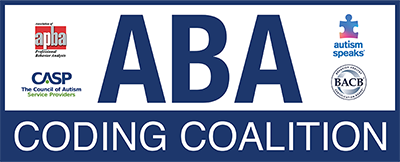Revised Code Conversion Table
October 19, 2018
In September, we distributed a code conversion table showing the most common HCPCS and 2014 Category III CPT codes that have been used to report applied behavior analysis (ABA) services to health plans, cross-referenced to the 8 new Category I and 2 modified Category III CPT codes that will go into effect January 1, 2019. Based on questions and feedback from many providers and payors, we have revised the code conversion table to clarify several points of confusion. Changes are as follows:
- The date of the revision is shown in the upper right corner of the table.
- The footnote defining QHP has been revised to be consistent with the American Medical Association (AMA) and Centers for Medicare & Medical Services (CMS) definition of Qualified Healthcare Provider: “A ‘physician or other qualified health care professional’ is an individual who is qualified by education, training, licensure/regulation (when applicable) and facility privileging (when applicable) who performs a professional service within his/her scope of practice and independently reports that professional service.” Note that decisions as to who can serve as a QHP for reporting the new CPT codes will be based on each state’s licensure laws (where applicable) and/or health insurance laws and regulations.
- A note has been added (page 1, lower right corner) to indicate that new CPT codes 97153 (adaptive behavior treatment by protocol administered by technician) and 97155 (adaptive behavior treatment with protocol modification administered by QHP, which may include simultaneous direction of technician) may be reported concurrently as long as the requirements encompassed in the descriptors for both codes are met and the providers performing the services are not the same individuals.
We would also like to take this opportunity to remind providers how important it is to obtain complete and accurate information about the new CPT codes. Although we certainly hope the code conversion table will be helpful, it is essential that you obtain and digest additional resources to ensure compliance with AMA coding and reimbursement rules and guidelines. Those resources include the 2019 CPT® code book and the forthcoming CPT® Assistant article, which will be published later this fall. They can be purchased from the AMA store, https://commerce.ama-assn.org/store/. Our Steering Committee is also preparing materials to help providers and payors implement the new codes. One of those resources is this set of suggestions to help providers prepare for implementation of the new codes.

